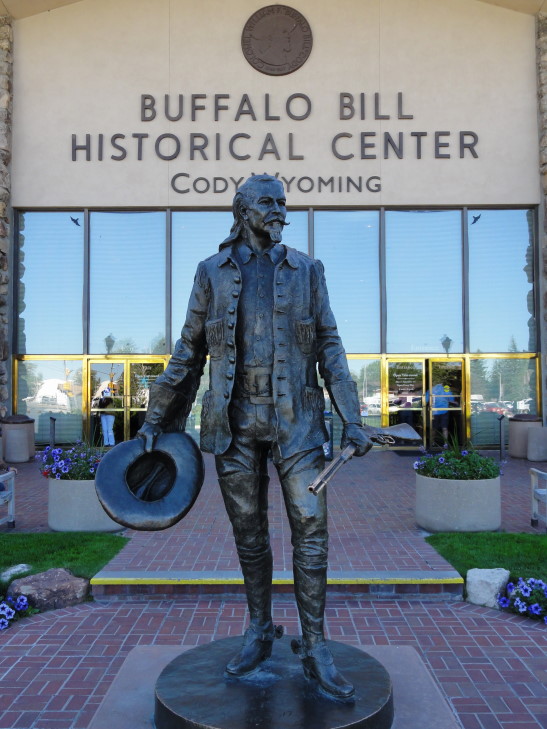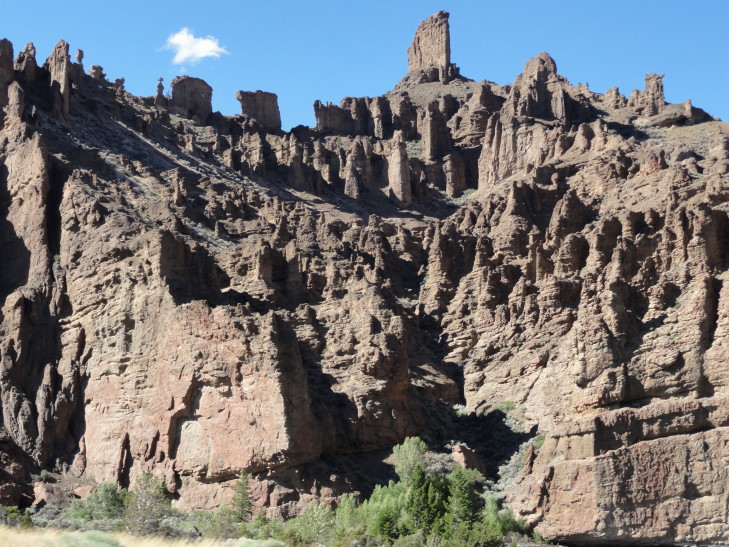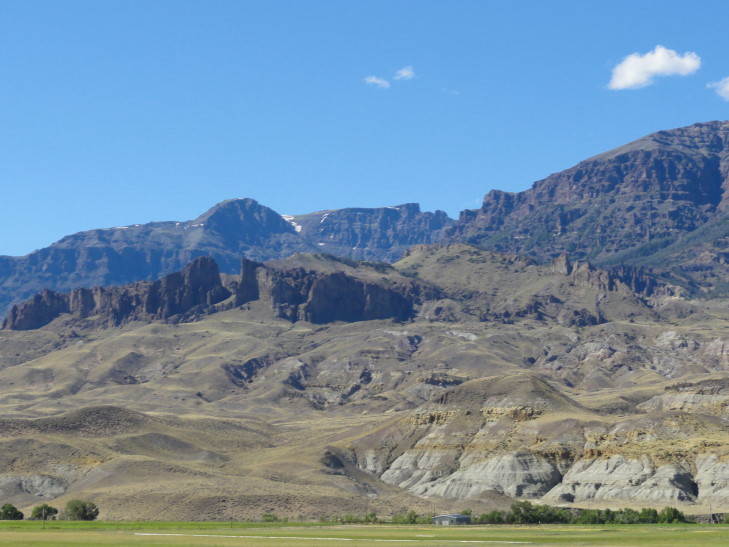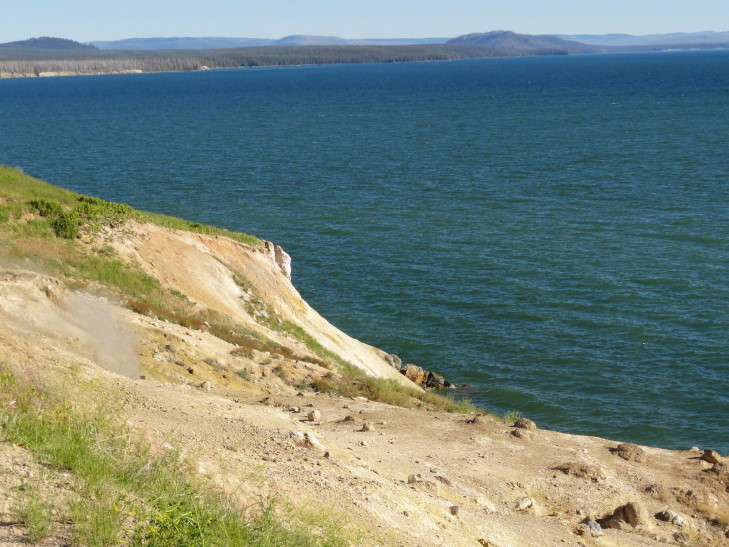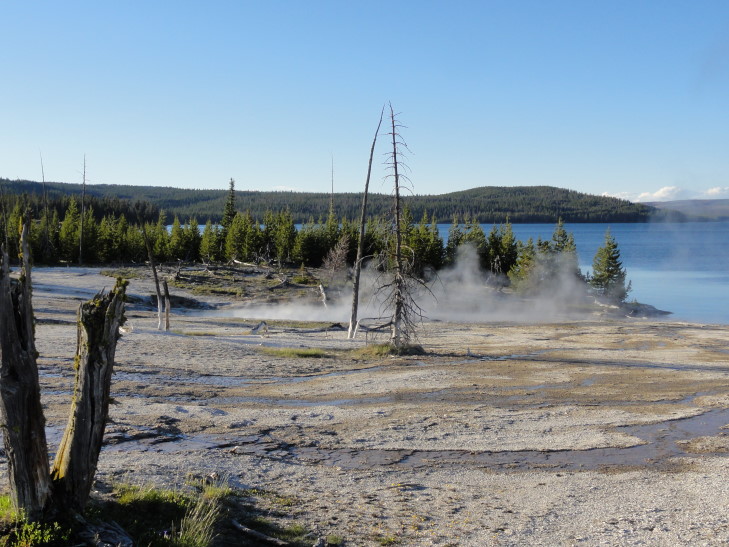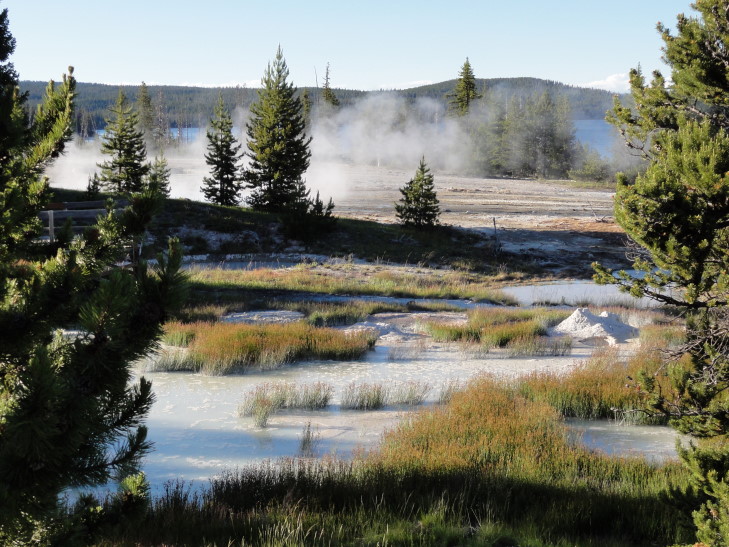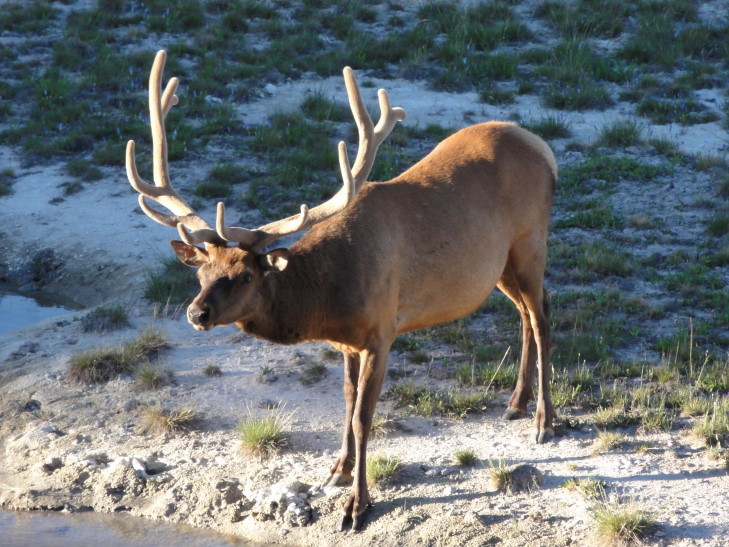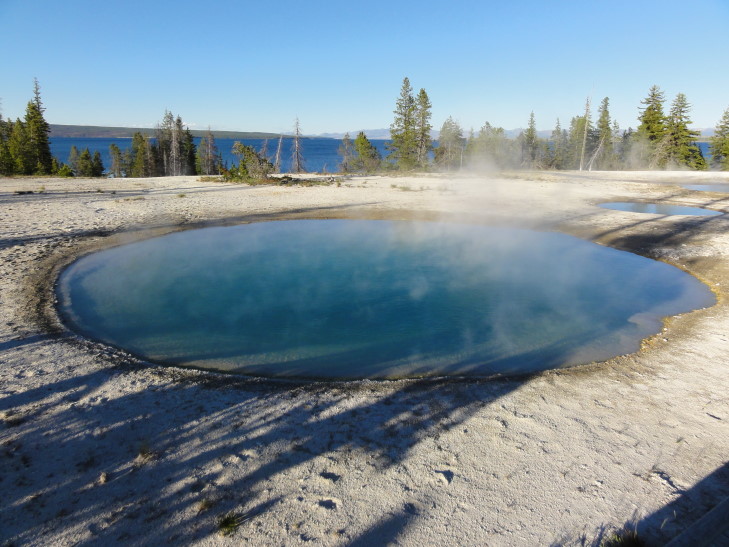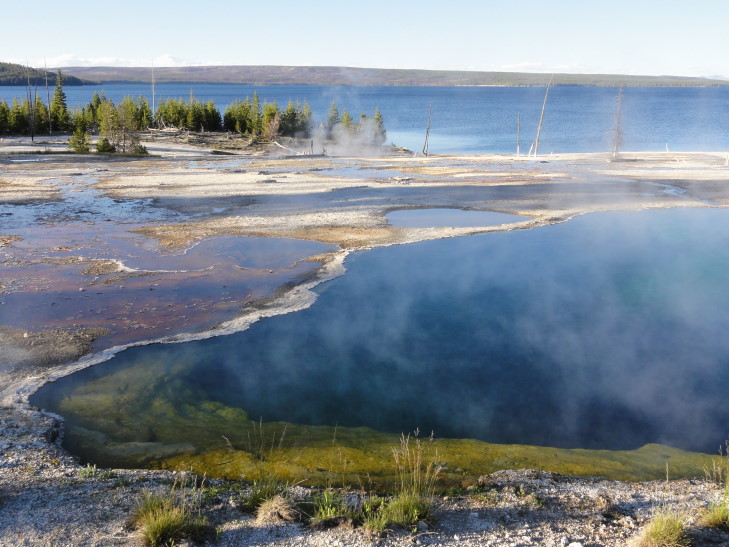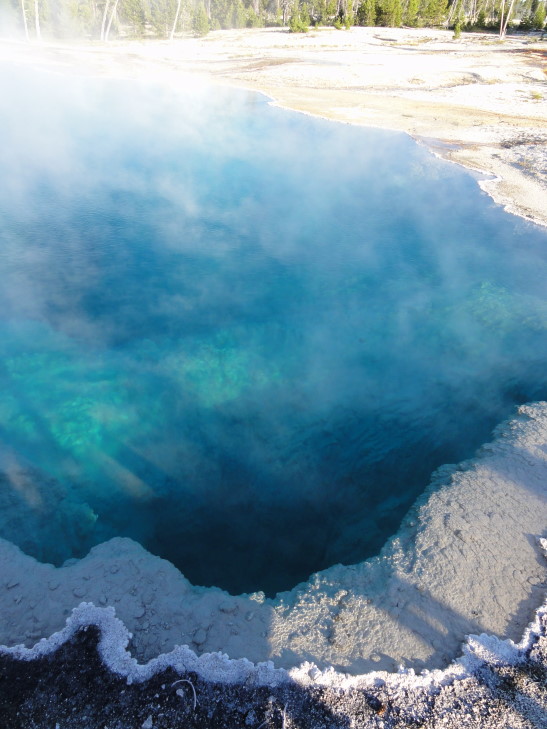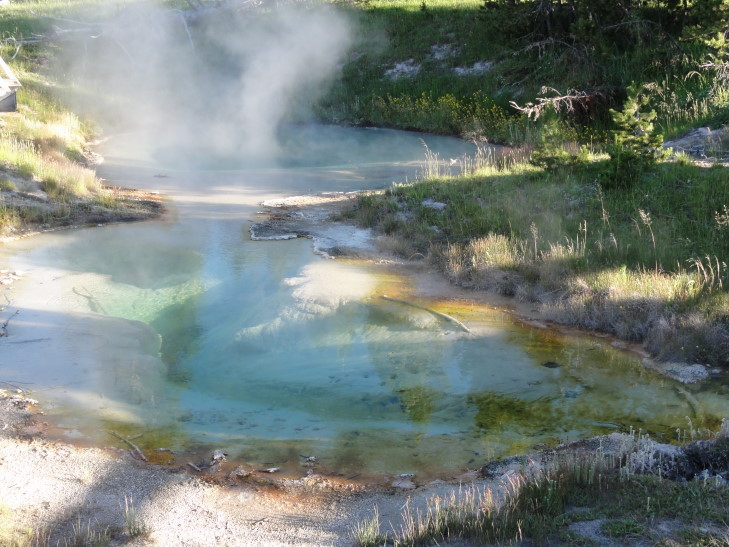Woke up and Michelle headed to McDonald’s to pick up breakfast (as our night in Cody did not supply the usual breakfast we had grown accustomed to). Checked out and headed to the Buffalo Bill Historical Center only a couple of blocks from our hotel.
What a great museum! Well, actually, more like five museums in one. We started with the wing dedicated to the Plains Indians (with a nod towards other Indian cultures such as the Inuit and Northwest peoples). I particularly enjoyed seeing the small shields (more like bucklers) that they carried into battle. They were decorated (one even incorporated a complete dead small bird) and something I normally didn’t imagine the Indians using much of. Also learned such interesting things as the children learned to put up tipis (note, not teepees) on small scale models and that dogs pulled many of the tribes’ belongings (even after the introduction of the horse). A dog can pull 75 pounds of gear. Genetta particularly enjoyed seeing some bows (even one completely covered in rattlesnake skin, though she vowed she’d never use that one) and arrows. Also covered some of the conflicts as the United States expanded westward.
The second wing was an art gallery. They had many great paintings and sculptures including “Madonna of the Prairie”, some paintings by George Catlin (not to be confused with that other genius), and plenty of Frederic Remington paintings and sculpture. Remington produced a staggering 3,000 works from his studio in New Rochelle, New York. His studio had tons of western objects and such to inspire him. They also had some N. C. Wyeth works, an artist I like. Finally they had a very interesting painting depicting the Battle of the Little Bighorn (a.k.a. Custer’s Last Stand), though it was referred to as the Battle of Greasy Grass Creek as it was done by a Native American illustrator. What was interesting about it was that rather than showing one moment of the battle it represented all of the battle — parts of the painting depicting events also showed had the time indicated. Addison and Genetta both took some time to draw at an activity center as well.
The third wing was all about firearms. It houses the largest collection of American firearms in the world and, in total, has 2,700 weapons from hand cannons of the 15th century through modern weaponry. Addison loved this wing, as expected. We all particularly enjoyed seeing the evolution of weaponry through the ages and particularly the dead-ends (especially attempts to introduce more than one bullet such as several guns with multiple barrels before they hit upon the solution). There was even a gun attached to a swivel with four trip wires that would fire when any wire was tripped — intended to protect watermelon patches from deer.
The fourth wing was dedicated to the natural history of Yellowstone. It was informative but we were getting a bit ansy (ok, I was) to get on our way to our hotel so we blew through it. A mosaic of the Yellowstone area was very interesting, however, and I am indebted to it for giving me the name of the area we drove through the night before on the way to Cody: the Bighorn Basin.
Before entering the fifth wing we checked out an exhibit of photographs by Gertrude Kasebier (I’m not going to attempt to represent the umlaut in her name on this blog — I’ll probably crash it) that covered the Indians in Buffalo Bill’s Wild West Show. Fascinating stuff and a few were particularly intimate. One difficulty she had was photographing children as they believed that it could steal their soul and kill them. She persisted, however, in doing the session. A few weeks later she went back to visit and everyone was grabbing their kids and keeping away from her — one of the girls had died.
The fifth wing was dedicated to Buffalo Bill and his Wild West Show. We learned a ton there, such as Buffalo Bill being a Congressional Medal of Honor recipient and two of his performers being from Riverhead, New York (a town near to some of my family’s history). Lots of incredible artifacts there like many of his belongings as well as Annie Oakley‘s saddle and riding suit and even his boyhood home, shipped in from Missouri. Fascinating stuff but by that time we were zipping through.
I apologize for the long discussion on the museum but it did take up a big portion of the day so to omit it wouldn’t be right. I’ll try not to let culture invade this blog again! I also didn’t want to post any pictures from the museum as I’m not sure what I have a right to do with them, so here’s one from the entrance showing a statue of Buffalo Bill.
Oddly enough, Addison is the one that takes the longest in museums as he tries to read everything. I used to be that way but I’ve since gotten to the point that I prefer to hit the highlights. Having already had lunch at the museum (they had these very odd almost red potato chips that were quite good) we left directly from the museum to head towards Yellowstone by taking US-20 through the Absaroka Range.
The terrain started out quite arid with many jagged peaks with rock formations that looked like a toothy grin. Before entering the range we had feared that there’d be a lot of climbing and such but a series of tunnels fixed that. Addison was very grateful — the trip through the Bighorns the day before had been hell on his ears. There was also a reservoir, Buffalo Bill Reservoir, that was quite scenic. As we neared Yellowstone the terrain became a bit more tree-filled and we passed a number of ranches (mostly dude ranches).
We finally made it to the east entrance to Yellowstone and paid our $25 per vehicle entry fee (good for a week, though). The east entrance is quite alpine with long climbs and many twisty curves. To the right the walls of the mountains rose just feet from the car, broken only by small waterfalls. The left plummeted into the valley below. We were very nearly at the height of the snow on a few of eastern Yellowstone’s peaks and also caught many sights of Yellowstone Lake to the west and south as well as the far distant, snow-capped Grand Tetons.
The road eventually settled to the level of Yellowstone Lake. I was struck by how large it was (turns out it is the largest high altitude lake in the United States). Large enough that even without a stiff breeze there were some little waves washing on the rocky shore. One of the first places we came across was a place called Steamboat Point. It was remarkable because steam was coming out of the ground in several places. This area of the lake and lake shore was on top of a hot spot that ran into the mountains surrounding the lake. You could even see an area on the mountainside where all of the trees were dead due to the hot spot.
We then went on to a smaller lake that was actually formed when a hot spot exploded, sending hundreds of tons of rock into the air and creating a crater. That was many, many years ago, of course. Near the lake were two bison grazing. Some tourists were standing within arms reach of them — cuh-razy. Addison and I stuck to the trail and took pictures from a safe distance.
We continued to drive along the lake shore when we came upon the “West Thumb” and its thermally active basin. Michelle chose to remain in the car but the rest of us walked around the basin on an elevated walkway. Genetta walked ahead of us and headed back to the car while Addison and I took our time to see everything close-up. In addition to the geological wonders (no geysers, but some springs and hot pools) there were a fair number of elk (that Addison kept amusingly — at first, at least — referring to as donkeys, camels, and horses) and even a bull elk with a huge rack of antlers.
I’ve taken quite a liking to the hot pools in particular with their steam, bubbles, clear water, and breathtaking colors. The hotter the pool the bluer. Cooler water (though still very hot!) brings with it algae and such that change the color into greens, browns, and oranges.
I wish I could remember the names of all the individual hot pools and the like but there are so many of them and they all have similar names like Opal Pool, Sapphire Pool, etc. The steam coming up from some of them stank of sulfur. Addison took great pleasure in accusing me of farting, my response (“It wasn’t me, I didn’t do it!”) forming the title of today’s blog.
One neat thing about the West Thumb Basin is that it is one of the few thermal zones in Yellowstone that is right on the lake — in this case right on the West Thumb (which, incidentally, was formed much in the same way the other lake I mentioned was — a massive explosion).
After West Thumb Basin we proceeded past many of the more famous sights in Yellowstone (including Old Faithful and the Grand Prismatic Spring) as it was getting dark and we needed to get to our hotel. And, oh, eat. Checked in to our hotel and then immediately went to eat at the Timberline Cafe. Pricey but not too bad.
Tomorrow will be fun — going to see more of Yellowstone’s thermal features like Old Faithful and more hot pools, springs, and the like.
